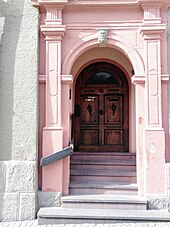House at the Rindermarkt (Rottweil)
The house on Rindermarkt is in a prestigious location on Friedrichsplatz in Rottweil . The house, built in the first half of the 14th century, was acquired in 1495 by Johann Werner the Elder von Zimmer (1454–1495) for his wife Margareta von Öttingen († 1528) before his death. She lived there for several years as a widow with sons and daughters. The building is in close proximity to the Predigerkirche at Friedrichsplatz 9.
History of the building
When it was bought, the house at Rindermarkt probably consisted of two buildings, which were built in two phases in 1321 and 1346/1347 and were completely rebuilt in the following period. After the death of the mother Margareta von Öttingen († 1528) the house passed into the possession of the eldest son Johann Werner von Zimmer , who lived there during the Peasants' War and later transferred the management of his property to the house on Rindermarkt. He lived there - cared for by Rottweiler surgeons - as a sick man until he died in 1548. The inheritance went to Froben Christoph von Zimmer and subsequently to his son Wilhelm . When the count family died out with the death of Wilhelm von Zimmer, the city of Rottweil acquired the building from his estate in 1595.
The city used it as a grammar school from 1655 to 1722, and from 1790 until the end of the imperial city period as a mansion. At the beginning of the Württemberg period, the mayor, city commandant and officers lived in the house. In 1819 the house was acquired by the Protestant parish, which used it as a Protestant elementary school and official residence of the city pastor.
After 1907, the house was department store, in 1919 it became the property of the Jewish businessman Max Blochert over and was under the name Max Blochert, formerly Steinberg & Co out. In January 1939 Max Blochert (* 1879 Grimmen † 1944 Tel Aviv) sold the office building to Gustav Witzemann and his wife under the direct pressure of the November pogrom and the ensuing imprisonment in the Dachau concentration camp . Long after the war, the department store was still called Kaufhaus Witzemann . The widow Celine Blochert waived in a settlement in 1950 before the Rottweil Regional Court to annul the contracts that had been concluded between 1936 and 1939. She received a payment of 25,000 DM for this. The house remained in the possession of the Witzemann family.
literature
- August Steinhauser: Rottweiler houses . The oldest houses in the city. The houses of the lords of rooms in Rottweil . Rottweil [1955]. P. 47ff.
- Winfried Hecht: Cultural monuments in Rottweil . Rottweil 1997, p. 50f.
- Dorothee Ade-Rademacher, Winfried Hecht, Marianne Dumitrache a. a: Rottweil . In: Regional Council Stuttgart. State Office for Monument Preservation (Ed.): Archaeological City Register Baden-Württemberg . tape 30 , 2005, ISBN 3-927714-84-4 , pp. 225 .
- Casimir Bumüller, Bernhard Rüth, Edwin Ernst Weber (eds.): Patrons, collectors, chroniclers. The Counts of Zimmer and the culture of the Swabian nobility. Stuttgart 2012, ISBN 978-3-7630-2625-8 . , P. 65ff.
- Cornelia Votteler: Margarethe von Öttingen (died 1528) in the mirror of the Zimmerische Chronik. In: Rottweiler Geschichts- und Altertumsverein (Ed.): Rottweiler Heimatblätter 75th year (2014), No. 4 ( PDF file )
- Bettina Eger-Heiß: The end of the Max Blochert and Bermann & Wälder business premises in the restitution proceedings of the Rottweiler District Court. In: Heinz Högerle, Peter Müller and Martin Ulmer (ed. On behalf of the Gäu-Neckar-Alb Memorial Association, State Archives Baden-Württemberg, State Center for Civic Education Baden-Württemberg): Exclusion-Robbery-Destruction. Nazi actors and "Volksgemeinschaft" against the Jews in Württemberg and Hohenzollern 1933 to 1945 . 2019 ISBN 978-3-945414-69-9 , pp. 521-532.
Web links
- Herrentrinkstube am Rindermarkt in the database building research / restoration of the State Monuments Office 2004-2020
Coordinates: 48 ° 10 ′ 6.2 " N , 8 ° 37 ′ 36.3" E
